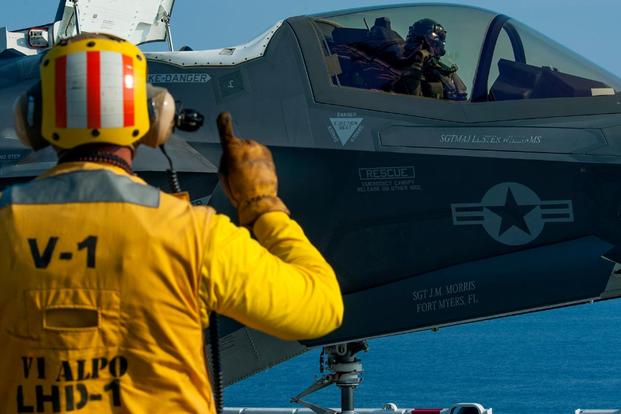The military's fifth-generation stealth fighter jets teamed up to train in Hawaii before Marines head to the Middle East in what could be the F-35B's first-ever combat deployment.
Members of Marine Fighter Attack Squadron 211 and the Hawaii Air National Guard flew F-35B Lightning IIs and F-22 Raptors far out over the Pacific Ocean last week.
The exercise not only gave Marines a chance to conduct air-to-air operations against another fifth-gen fighter, but also symbolized a real transformation for military aviation, said Col. Chandler Nelms, commanding officer of the 13th Marine Expeditionary Unit.
"I think it's the future," he told Military.com. "We're transitioning from a fourth-generation air wing in the Marine Corps to a fifth-generation. Seeing us there with the Air Force's fifth-generation capability, you can tell that things are changing."
The 13th MEU will spend seven months patrolling the Western Pacific, Indian Ocean and the Middle East while embarked with the Navy's Essex Amphibious Ready Group. This will be the first time the F-35B will operate in the U.S. Central Command area of responsibility, which includes Syria, Iraq and Afghanistan.
"The F-35B is really a fighter and attack aircraft," Nelms said. "... It can defend both Marines on the ground from air attack and it can defend the embarked force, the amphibious ready group."
Adding fifth-generation capabilities like the F-35 to an ARG-MEU is a game-changer for the Navy and Marine Corps team, said Marine Maj. Gen. David Coffman, director of expeditionary warfare. The F-35B not only increases lethality, he said, but also survivability.
"The agility and breadth of capability inherent in these platforms offers the naval commander a nearly endless menu of force-employment options," he said Tuesday at the U.S. Navy Amphibious Warship Congressional Forum in Washington, D.C.
In Hawaii, the fighter pilots traded off playing blue and red teams -- or good and bad guys, Lt. Col. Kyle Shoop, the F-35 squadron's commanding officer, told Hawaii News Now.
That's valuable training in an aircraft that significantly expands what Marines are able to do in the battlespace, Nelms said, in an aircraft that's low-observable, highly capable and carries more ordnance than its predecessor.
"The pilots said it was extremely valuable -- not only just for the chance to fly and conduct air-to-air, but specifically to work with the F-22s," he said. "It was a really unique and key opportunity for us to take advantage of while we were in Hawaii."
This was the ARG-MEU's final training stop before it officially begins its deployment. The Marines also conducted amphibious landings and live-fire and urban warfare training in preparation for the crisis-response mission they could face while deployed.
"We're just looking forward to seeing what the [F-35B] can do ... to support the Marines on the ground," Nelms said.
-- Gina Harkins can be reached at gina.harkins@military.com. Follow her on Twitter at @ginaaharkins.














